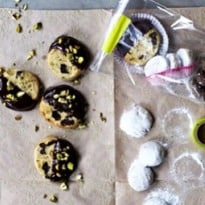Cookies, nougat, truffles and more: bake and wrap for brilliant, personalised presents
My grandma Ptak, who lived in the heart of Illinois, would make no less than a dozen varieties of cookies every Christmas for giving out as gifts. Chocolate crinkles, plantation creams, peanut butter balls, Toll House chocolate chip cookies, kolackies, red and green anise candy, gingerbread men, the list goes on. She had five sons and they all had their favourites. When my father moved to California she still sent them by post every year in a gigantic box. My father carried on the tradition and made his favourite, the apricot and walnut-filled cream cheese kolacky, the sole cultural link to our Polish heritage.
Baking and preserving during the holidays for gift-giving is one of my most cherished memories of California life. We would usually choose one day close to Christmas to shop for all of the special ingredients, one day for all the baking and one day for the packaging. Preserving would most likely have been done earlier and stored, so this got brought out too. Getting up just as the day breaks, we would put the kettle on to make coffee, tea and hot chocolate before setting to work.
When all the baking is cooling and resting, the table can be organised for wrapping. Cling film, paper, ribbons and labels collected throughout the year are laid out for inspiration. Make your own labels with stamps and hand-written messages. I like to spend as much time and care with the presentation as I do with the baking.
Buttermilk Christmas cookies
This recipe was born out of a desire to get three types of cookies for the time it takes to make one. A simple base is divided into three bowls and then different flavours are added to each to make three distinctly different shaped, flavoured and textured cookies.
Makes about 60 of each cookie
For the base:
soft unsalted butter 350g
caster sugar 150g
light muscovado sugar 200g
eggs 2
salt 1 tsp
buttermilk 200g
runny honey 2 tbsp
vanilla 1 tbsp
Use an electric mixer to beat the butter and sugars until pale and fluffy. Add the eggs, one at a time until they are incorporated. Add the salt, buttermilk, honey and vanilla, and beat well. Set aside. Now gather three mixing bowls (or pudding basins work well if you don't have enough bowls). Divide the butter mixture evenly between them (about 350g each). Add one of these sets of ingredients to each bowl to create three different cookies.
Chocolate ginger drops
plain flour 250g
cocoa 3 tbsp
ground ginger 1 tsp
demerara sugar 50g, for dredging
chocolate ganache ½ recipe (see below)
Add the flour, cocoa and ginger to the butter mixture and stir with a wooden spoon. Wrap with cling film and chill for 30 minutes. Roll into small balls. Roll the balls in the demerara and place on a parchment-lined baking sheet, pressing a dip into each one with your thumb. Bake for 15-20 minutes at 150C/gas mark 2 until set. Allow to cool while you make the ganache filling. Pipe or pour about half a teaspoon of ganache into each dip and leave to set.
Pistachio cherry slices
plain flour 250g
chopped pistachios 80g
dried sour cherries 100g
orange zest from 1
chocolate ganache ½ recipe (see below)
Add the flour, pistachios, cherries and orange zest to the butter mixture, and mix well with a wooden spoon. Roll into a log and wrap with baking paper. Chill for an hour. When ready, unwrap, slice into discs (about 20) and lay out on a baking-paper-lined baking tray. Bake for about 20 minutes at 170C/gas mark 3½ until just starting to turn golden. Allow to cool then dip each cookie halfway in the chocolate ganache. Lay on clean baking paper to set. These will travel best if put into individual paper cases so that the chocolate does not smear.
Walnut wedding cookies
plain flour 250g
walnuts 150g, finely ground
icing sugar for dredging
Stir the flour and walnuts into the butter mixture and mix well. Use a teaspoon to scoop small balls of dough. Roll into balls and bake for 20 minutes at 150C/gas mark 2. Remove from the oven and allow to cool slightly. Toss in icing sugar and allow to cool completely. Toss again in icing sugar.
Chocolate ganache
dark chocolate 200g, broken into pieces
unsalted butter 100g
golden syrup 1tbsp
Melt all together in a small bowl over a small pot of simmering water.
Blue cheese poppy-seed biscuits
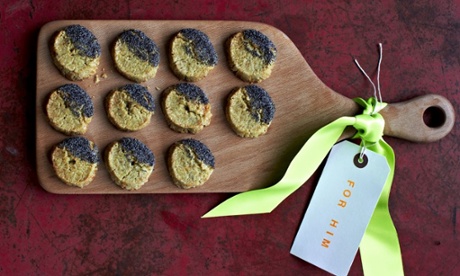
I had some beautiful light-blue poppy seeds and I thought they would be so nice with some good blue cheese in a short savoury biscuit. The results are tangy and buttery and just the thing with Christmas cocktails.
Makes about 36 biscuits
plain flour 150g
crumbly blue cheese 100g, cut into small pieces
unsalted butter 100g, at room temperature, cut into small pieces
egg 1, separated
salt ¼ tsp
freshly cracked black pepper 1 tsp
poppy seeds 2 tbsp (blue ones if possible)
Put all the ingredients except the egg white and the poppy seeds into a food processor and mix until it just comes together in a ball. Lightly whisk the egg white in a small bowl and set aside.
Divide the dough into two and on a lightly floured surface roll each piece into a log about 3cm thick. As the dough is formed into a log, press a ruler or straight edge against the log of dough to help form a long narrow cylinder. Wrap in baking paper and chill for an hour before slicing into discs about 1cm thick. Rotate the log as you slice it so that the bottom does not flatten out.
Heat the oven to 200C/gas mark 6 and line two baking trays with greaseproof paper.
Fill a small bowl with the poppy seeds.
Take each biscuit and dunk it first into the egg white, about half way up the biscuit, shaking off any excess. Next dunk the biscuit into the poppy seeds and lay on your prepared trays. Space the biscuits about 2 centimetres apart. You are trying to get a nice straight line down the centre of the biscuit, half plain, half covered in the seeds.
Bake for 12-15 minutes until just starting to turn golden.
Cool on a wire rack and wrap in cling-film bags tied with ribbon or string. These will keep well for up to two weeks in an airtight container.
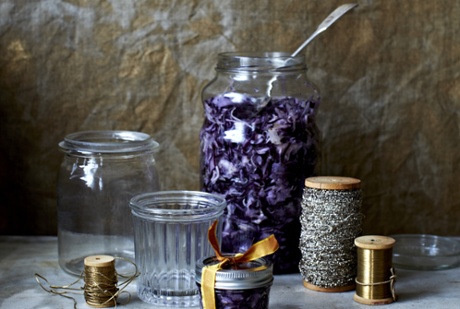
There are so many virtues to sauerkraut. Filling the house with wonderful smells, however, is not one of them. Find a nice cool secluded place as the cabbage can smell strong. As this version has no onions or garlic though, it is much milder. I love to add the caraway and celery seeds because they mean you can add less salt. The combination of red and white cabbage gives you a lovely purple-pink hue, perfect for gift-giving.
Makes about 4 jars
white cabbage 1kg, finely chopped or grated or sliced on a mandolin
red cabbage 1kg, finely chopped or grated or sliced on a mandolin
fine sea salt 2 tbsp
caraway seeds 1 tbsp
celery seeds 1 tbsp
You will need: 1-3 weeks; large bowl; ceramic crock or a food-safe plastic bucket with a lid; plate that fits inside the crock; a heavy weight - a jar with water in, or a heavy stone; pestle; tea towel
Put the cabbage in a large bowl as you prepare it and sprinkle with the salt as you go. Add the seeds and massage together for a few minutes. The cabbage should start letting out water, helped along by the salt.
Pack the whole thing including all the juices into your crock or bucket and press down firmly so that it is covered by the liquid. Place a plate on top of this and use the weight to add pressure. Cover with a cloth. You may not have much liquid at this point but check it every few hours for the first day, removing the cloth, weight and plate and applying pressure with clean hands. This will help extract more liquid. Eventually you should have about a centimetre or two of liquid above the top of the cabbage. Replace the plate, weight and cloth each time. You want the natural yeasts in the atmosphere to get into the container while keeping out flies and dust. Keep in a cool, darkish part of your kitchen.
The kraut will start to taste nice within a few days but improves greatly by the second week. Check it every couple of days to make sure it is still submerged, pressing down if not. If a little surface growth appears, simply scrape it off, it is not a problem.
When your kraut is ready, press it into sterilised jars with some of the liquid and a tight-fitting lid. Store in the fridge and when ready to give, wrap with a label that tells the recipient to store it in the fridge for up to 3 weeks.
Hazelnut and dried blueberry chocolate loaf
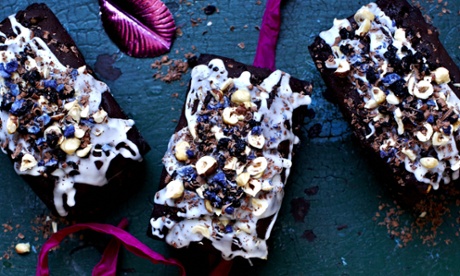
I used to say no to fruit and chocolate but then I discovered Cadbury's fruit and nut when I moved to London almost a decade ago. This malted chocolate cake is a play on that. I opt for dried blueberries over currants to cut through the dark chocolate. But good currants would be great too. I barely chop the hazelnuts because I like the crunch of a nearly whole one next to a sticky-sweet berry suspended in the chocolate crumb. I also add chunks of milk chocolate to bring it all together.
Makes 3 small gift loaves or 2 large ones
70% dark chocolate 175g, plus 25g for grating on top
unsalted butter 175g
plain flour 200g
malt powder such as Horlicks, 100g
cocoa powder 50g
caster sugar 250g
bicarbonate of soda ½ tsp
fine sea salt ¼ tsp
milk 80g
eggs 3
boiling water 150g
milk chocolate 150g, broken into pieces
whole hazelnuts 200g, well toasted, skin rubbed off, and barely chopped
dried blueberries 180g
icing sugar 4 tbsp
candied violet petals 2 tbsp, slightly crushed
Heat the oven to 190C/gas mark 5. Butter three 10x16cm loaf tins (1lb loaf tins) or two 10x20cm and line with baking paper.
Break up the 175g of dark chocolate into small pieces and melt it with the butter in a heatproof bowl over a pot of simmering water. Meanwhile, weigh out all of the dry ingredients except the milk chocolate, hazelnuts and blueberries into a mixing bowl and whisk together.
In another bowl, weigh out the milk and eggs. Whisk them together and set aside. When the chocolate is melted, whisk together well and allow to cool slightly. Whisk the milk and eggs into the chocolate before adding it into the dry ingredients. Now whisk in the boiling water until smooth and glossy. Fold in the milk chocolate pieces, 175g of the hazelnuts and 150g of the blueberries. Pour into the prepared tins and bake for 45-60 minutes.
Cool for 20 minutes before removing from the tins. In a small bowl add a few drops of water to the icing sugar and mix into a glaze. Brush on the warm loaf and sprinkle with the remaining hazelnuts and blueberries and the violet petals. Grate the remaining chocolate over the top. Cool completely before wrapping in cling film.
Raw cashew-cardamom goji truffles
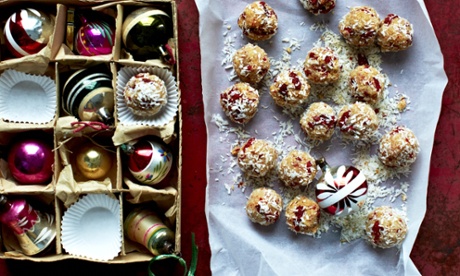
Goji berries have a lovely flavour when mixed in with other fruits and nuts and the colour is striking. These are very festive and quite virtuous little balls.
Makes about 20 truffles
cashews 100g
desiccated coconut 100g plus more for dredging
salt a pinch
lemon juice 1 tbsp
lemon zest of 1
ground cardamom ¼ tsp
vanilla 1 tbsp
agave nectar 1 tbsp
goji berries 50g
In a food processor, blend the cashews, coconut, salt, lemon juice and zest and cardamom until a fine powder.
While the blender is on add the vanilla and agave until it comes together in a nice sticky ball. Add a little more lemon juice if needed.
Add the gojis and pulse for a further couple of seconds so that the berries just start to break up.
Roll the mixture into small balls and then roll in more coconut to coat. Chill for about an hour. Place in little truffle cases and package up. Best to keep these in the fridge but they would be fine at room temperature for a couple of days.
Cherry, fennel and white chocolate-pistachio nougat
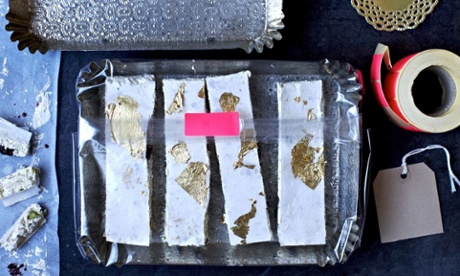
Nougat has a cousin in America called divinity. Soft meringue-like candies that are filled with nuts and fruit. Tart cherries, sweet white chocolate and pistachios meld together very well here. The fennel adds a special note of warming spice that balances it all out, and surprises you.
Makes about 10 nougat bars
rice paper 3 A4 sheets
whole almonds 100g, skins on
pistachios 200g
glacé cherries 100g
white chocolate 100g, in chunky pieces
fennel seeds 2 tsp
egg whites 2
caster sugar 350g
fine sea salt ¼ tsp
vanilla 1 tsp
water 50g
golden syrup 1 tbsp
honey 100g
real gold leaf 3-4 sheets (optional)
Heat the oven to 180C/gas mark 4 and lightly oil a 20x30x5cm baking tin and line with one sheet rice paper. Cut a second sheet of rice paper in half lengthwise and press against the long sides of the tin. Set aside.
Toast the almonds on a baking tray in the oven until lightly golden. This should take about 5-7 minutes. Remove from the oven and add the pistachios to the almonds to simply warm the pistachios a little. Let the nuts cool before chopping roughly.
Gently heat a clean dry frying pan and add the fennel seeds. Warm them through but watch closely so that they do not burn. You just want to release their fragrant oils.
Place the egg whites with 100g of the caster sugar, salt and vanilla into the bowl of an electric mixer. Whisk to stiff peaks, then turn off the mixer and leave there while you make the syrup.
Put the water, remaining caster sugar and golden syrup into a heavy bottomed pan and set over a medium heat, swirling the pan occasionally to assist the melting of the sugar but not stirring which can cause crystallization. Once melted, turn the heat up to medium high and add a candy thermometer. Heat until the syrup reaches 164C - this should take 10-15 minutes.
Meanwhile, gently warm the honey (do not let it boil) and set aside while you wait for the sugar syrup to reach temperature.
Turn the mixer back on, whisking the whites again slowly as you drizzle in a slow steady stream the sugar syrup followed by the honey. Turn up the speed to high and continue to whisk until the mixture is pale, fluffy and thick.
You will need to work quickly now, to get everything mixed in properly. Add the nuts, cherries, white chocolate and fennel seeds to the egg white mixture and fold together well. Spoon the mixture into the prepared tin and smooth the surface with a palette knife or if the mixture is too dense already, press down with damp hands. Place the remaining sheet of rice paper on top. Lay a piece of baking paper over the rice paper and place a chopping block or heavy book on top to weigh it down. Leave to set for about 3-4 hours before turning out and cutting into 10 bars, crossways. Press bits of gold leaf onto the top of the nougat bars. It is better to cut the bars first as the knife cutting through the gold leaf can damage the delicate gold. Wrap in baking paper and twist the ends. Will keep for up to a week in an airtight container.
Claire Ptak's The Violet Bakery Cookbook is published in March by Square Peg (£20). To pre-order a copy from the Guardian Bookshop for £17.99, click here
Buttermilk Christmas cookies. Photograph: Kristin Perers for Observer Food Month








